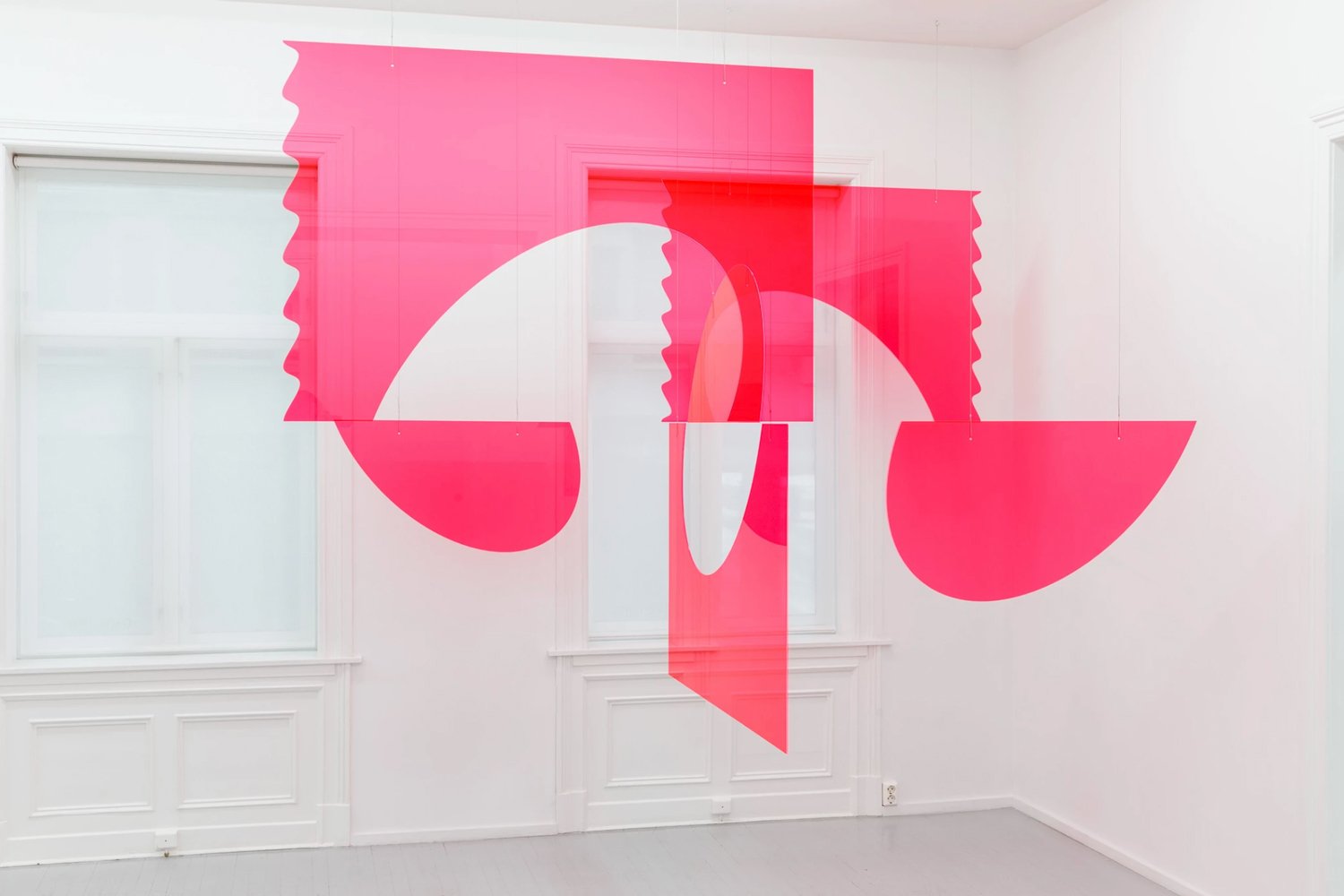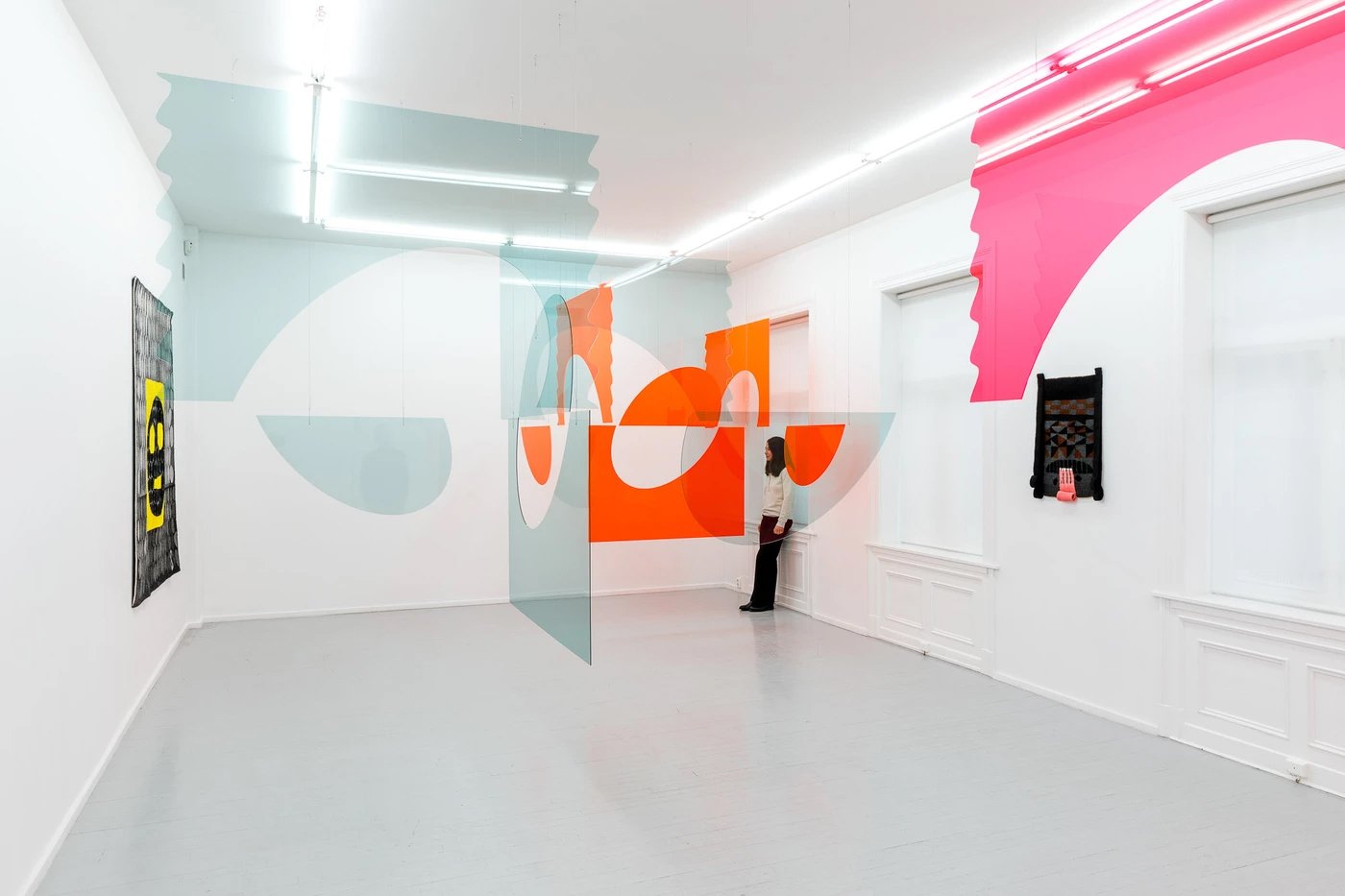We are pleased to present the exhibition Vår with Siri Aurdal (1937 – ) and Synnøve Anker Aurdal (1908 – 2000). The structure of the exhibition is set by the new installation Almanakk by Siri Aurdal, which consists of colored and fluorescent plexiglas, hanging from the ceilings in all of the gallery’s exhibition spaces.
Almanakk is developed from the four plexiglas modules that Aurdal made for the group exhibition Et kollektivt kaosmos at Kunsthall Oslo in 2020.
Foto: Adrian Bugge // Copyright © Galleri Riis
In material and concept, it follows from Aurdal’s earlier plexiglas installations such as Interview and Conversation, but in form Almanakk is distinguished by a module consisting of six elements, which are repeated in three different colors throughout the exhibition spaces. The modules are spaces in themselves, but they also create new spaces between themselves. In these ‘spaces’, a selection of larger and smaller tapestries by Synnøve Anker Aurdal, from 1970 to 1999, are displayed.
The two artists, mother and daughter, shared a profound interest in experiments with new materials and a commitment to social and political issues; yet they exhibited together only once during Anker Aurdals’ lifetime, when the exhibition Three Generations with Gunvor Anker, Synnøve Anker Aurdal and Siri Aurdal, was featured at the Museum of Applied Arts, Oslo in 1974.
In Oslo’s new National Museum, Anker Aurdal’s seminal work Magisk måne (1967) is prominently displayed in the collection galleries, and Siri Aurdal’s monumental Bølgelengder (1969-2016) is installed in the museum’s large atrium.
The exhibition title, Vår, holds a double meaning in Norwegian – Our and Spring.
Siri Aurdal
Almanakk, 2020-23
Modules in colored, clear and fluorescent plexiglas Each module consists of 6 elements and measures ca. 194 x 194 x 284 cm, Ed. 3 + 1 AP. Foto: Adrian Bugge // Copyright © Galleri Riis
Siri Aurdal (b. 1937 in Oslo) received her artistic education from Statens Håndverk og Kunstindustriskole and Statens Kunstakademi in Oslo 1956-61, with a focus on figurative sculpture and printmaking. After an exhibition at Galleri Kringla in Oslo in 1968, where she for the first time showed an installation with elements of colored plexiglas, her interest went in the direction of sculpture made from industrial products designed for construction and infrastructure. Aurdal was an active and innovative artist throughout the 1960s and ´70s, and as part of the politically radical artist group GRAS, Aurdal’s module-based sculptures and choice of materials expressed a belief in the political, collective and social role of art. The exhibition Omgivelser (Environments) at Kunstnernes Hus in 1969, consisted of a monumental sculpture composed of several units assembled from fiberglass reinforced polyester tubes, and was a striking manifestation of her ability to design large scale structures with prefabricated materials.
In 2016, in collaboration with the artist Eline Mugaas, this work was reconstructed with the title Bølgelengder (Wavelengths) in the exhibition Aurdal/Mugaas at Kunstnernes Hus, and led to a renewed interest in Aurdal’s artistry. In 2017, Aurdal represented Norway in the Nordic pavilion at the Venice Biennale, and in 2018 Malmö Konsthall presented Continuum, her largest exhibition to date. For the opening of the National Museum in Oslo in 2022, the work Bølgelengder was installed in the building’s largest atrium. Siri Aurdal lives and works in Oslo. She is the daughter of artists Synnøve Anker Aurdal and Leon Aurdal.
Synnøve Anker Aurdal (b. 1908 in Kristiania – d. 2000 in Oslo) was one of Norway’s leading textile artists, and since the 1960s an important innovator in the tapestry tradition of this country. With deep knowledge of both Norwegian weaving tradition and the contemporary art discourse, Anker Aurdal was a pioneer. From working with traditional techniques in the field of Arts and Crafts, she moved towards the visual arts scene, where she gained a central position and was instrumental for the understanding of textile art as a relevant medium for contemporary artistic expression. By introducing new materials into her tapestries with an increasingly bold visual language, she played an important role as modernism gained a foothold in Norway in the 1950s. Through motifs and text references, she often commented on topics of her time with satirical humor. Words and phrases often appear in the works, and poetry was an important inspiration in her creative process.
Her insistence on the relevance and possibilities of textile art was radical for her time, and together with Hannah Ryggen (1894-1970), she was an important champion in establishing tapestry as an integral part of the Norwegian visual art scene. Synnøve Anker Aurdal was a prolific artist and worked continuously until her death in 2000, just months before a planned solo exhibition at Vestlandske Kunstindustrimuseum (KODE) in Bergen.
Anker Aurdal is represented in most major collections and museums in Norway, and has carried out many public commissions, e.g. Høyseteteppet, 1961 in Håkonshallen in Bergen (together with Sigrun Berg and Ludvig Eikaas), and the monumental Rommet og ordene, 1977, which was Norway’s gift to Iceland’s 1100th anniversary. In 1982, Anker Aurdal represented Norway at the Biennale in Venice. In 2022, the Astrup Fearnley Museum in Oslo showed the most extensive exhibition of her work to date, and the museum is currently working on a comprehensive monograph on the artist.
-
Vi er glade for å kunne presentere utstillingen Vår med Siri Aurdal (1937-) og Synnøve Anker Aurdal (1908-2000). Utstillingens struktur settes av Almanakk, en ny installasjon av Siri Aurdal, bestående av hengende elementer i farget og fluoriserende pleksiglass, som tar i bruk alle galleriets utstillingsrom. Almanakk er en videreutvikling av fire moduler i pleksiglass som Aurdal laget til gruppeutstillingen Et kollektivt kaosmos i Kunsthall Oslo i 2020, og føyer seg materielt og konseptuelt inn i rekken av Aurdals tidligere hengende pleksiglass-installasjoner som Interview og Conversation. Formelt utmerker Almanakk seg ved å være en modul bestående av seks elementer, som gjentas i tre ulike farger gjennom utstillingen. Modulene er både rom i seg selv og danner nye rom seg imellom. I disse mellomrommene vises et utvalg av større og mindre verk fra 1970-1999 av Synnøve Anker Aurdal.
Foto: Adrian Bugge // Copyright © Galleri Riis
Kunstnerne, som er mor og datter, delte interessen for en eksperimentell materialbruk i kunsten og begge hadde et stort engasjement for kvinnesak og kunstpolitiske spørsmål. I Anker Aurdals levetid stilte de ut sammen kun en gang, da utstillingen Tre generasjoner, med Gunvor Anker, Synnøve Anker Aurdal og Siri Aurdal ble vist på Kunstindustri-museet i Oslo i 1974. I det nye Nasjonalmuseet i Oslo henger Anker Aurdals hovedverk Magisk måne (1967) i museets basisutstilling, og Aurdals Bølgelengder (1969-2016) er installert i museets største atrium.
Siri Aurdal (f. 1937 i Oslo) fikk sin kunstneriske utdannelse fra Statens Håndverk og Kunstindustriskole og Statens Kunstakademi i Oslo 1956-61, og arbeidet tidlig i sin karriere med figurativ skulptur og grafikk. Etter en utstilling på Galleri Kringla i Oslo i 1968, hvor hun for første gang viste en installasjon med elementer av farget pleksiglass, vendte hennes interesse seg mot skulptur laget av industrielle produkter for bygg og infrastruktur. Aurdal var en aktiv og nyskapende kunstner gjennom 1960- og 70- tallet, og som del av den politisk radikale kunstnergruppen GRAS uttrykte Aurdals modulbaserte skulpturer og materialvalg en tro på kunstens politiske, kollektive og sosiale rolle. Utstillingen Omgivelser i Kunstnernes Hus i 1969, bestod av en stor komposisjon i flere deler satt sammen av glassfiberarmerte polyesterrør, og var en slående manifestasjon av hennes evne til å bygge strukturer med prefabrikkerte materialer.
Foto: Adrian Bugge // Copyright © Galleri Riis
I 2016, i samarbeid med kunstneren Eline Mugaas, ble dette verket rekonstruert med tittelen Bølgelengder i utstillingen Aurdal/Mugaas på Kunstnernes Hus, og førte til fornyet interesse for Aurdals kunstnerskap. I 2017 representerte Aurdal Norge i den nordiske paviljongen på biennalen i Venezia, og i 2018 presenterte Malmö Konsthall Continuum, hennes hittil største utstilling. Til åpningen av Nasjonalmuseet i Oslo i 2022 ble verket Bølgelengder installert i museets største atrium. Siri Aurdal bor og arbeider i Oslo. Hun er datter av kunstnerne Synnøve Anker Aurdal og Leon Aurdal.
Synnøve Anker Aurdal (f. 1908 i Kristiania – d. 2000 i Oslo) var en av Norges fremste tekstilkunstnere, og siden 1960-tallet en viktig fornyer av billedvevtradisjonen her til lands. Med dyp kunnskap om både norsk vevtradisjon og samtidens kunstdiskurs ble Anker Aurdal en av fagets foregangspersoner. Fra å arbeide med tradisjonelle teknikker innen kunsthåndverkfeltet beveget hun seg mot billedkunstscenen, der hun fikk en sentral posisjon og hadde avgjørende betydning for forståelsen av tekstil som et relevant medium for kunstnerisk uttrykk. Ved å introdusere nye materialer i billedveven, i et stadig friere formspråk, spilte hun en viktig rolle da modernismen fikk fotfeste i Norge på 1950-tallet. Gjennom motiver og tekstreferanser kommenterte hun ofte aktuelle temaer i sin samtid med satirisk humor. Ord og fraser fra poesi dukker ofte opp i flere av verkene, og var en viktig inspirasjon i hennes arbeid.
Hennes insistering på tekstilkunstens muligheter var radikal for sin tid, og sammen med Hannah Ryggen var hun en viktig forkjemper for dens plass på den norske kunstscenen. Synnøve Anker Aurdal var svært produktiv og arbeidet helt frem til hun døde i 2000, like før en planlagt separatutstilling på Vestlandske Kunstindustrimuseum (KODE) i Bergen.
Anker Aurdal er representert i de fleste større samlinger og museer i Norge, og har utført mange offentlige oppdrag, bla. Høyseteteppet, 1961 i Håkonshallen i Bergen (sammen med Sigrun Berg og Ludvig Eikaas), og det monumentale Rommet og ordene, 1977, som var Norges gave til Islands 1100-årsjubileum. I 1982 representerte Anker Aurdal Norge på Biennalen i Venezia. I 2022 viste Astrup Fearnley Museet i Oslo den hittil største utstillingen av hennes arbeider, og museet arbeider nå med en omfattende monografi om kunstneren.
Siri Aurdal
Synnøve Anker Aurdal
Vår
March 18 – April 29, 2023
About Galleri Riis
Galleri Riis was founded in Trondheim in 1972 by collectors Inger and Andreas L. Riis, and it has been based in Oslo since 1980. From 2011 to 2017 the gallery operated a second space in Stockholm which confirmed the gallery’s importance on the Scandinavian art scene. The gallery now maintains a by appointment office and showroom in Stockholm; and in August 2016, the Oslo gallery relocated to a renovated 1890’s residential building in the city centre. The current exhibition program reflects a long-standing history, with a primary focus on important contemporary art from the Nordic countries including a selective spotlight on international artists. The gallery has over the years also mounted a number of historic exhibitions with contemporary and modern masters. Galleri Riis is owned and directed by Espen Ryvarden and Kristin Elisabeth Bråten.
Oslo
Arbins gate 7
NO-0253 Oslo
Norway
Tuesday – Friday 12-17
Saturday 12-15
+47 22 94 40 40
info@galleririis.no
Espen Ryvarden
Kristin Elisabeth Bråten
Anita Gadelius
Blair Kincaid
Stockholm
Jakobsgatan 27C
SE-111 52 Stockholm
Sweden
By appointment
Klara Rudebeck
+46 (0)70 508 09 49
info@galleririis.se






